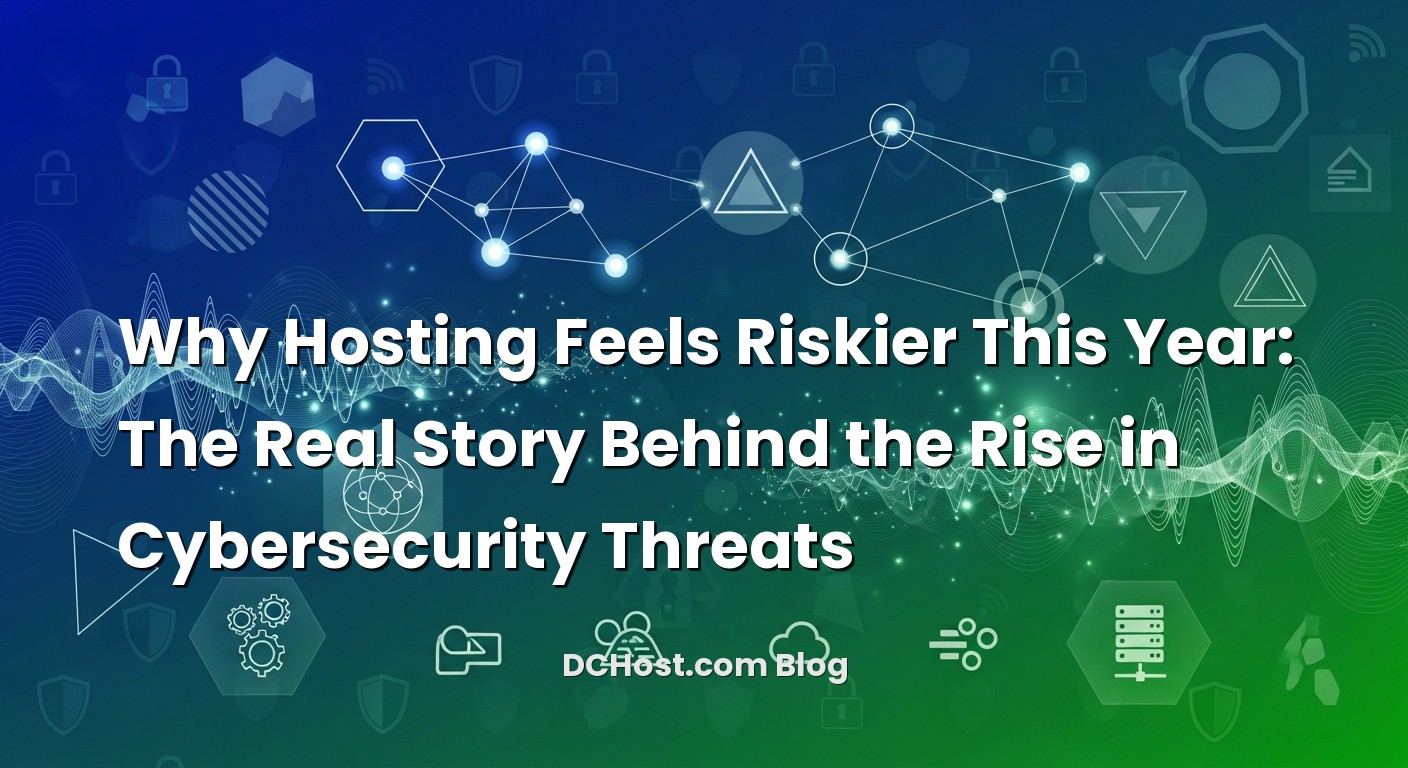So there I was, late on a Tuesday night, nursing the last of my coffee when a client pinged me: “Is it just me, or did our site turn into a brick?” Traffic was through the roof, but conversions were flatlining. At first glance, it looked like a marketing miracle—until we noticed that the traffic wasn’t human. It was a swarm of junk requests pounding the server from every angle, like rain on a tin roof. Ten minutes later, something else started: login attempts by the thousands, each one guessing a password that had probably been reused somewhere else. That night stuck with me. Not because it was the worst attack I’ve seen, but because it felt like a snapshot of where hosting is today—busy, noisy, and under fire from every direction.
If you’ve ever woken up to an “all hands” alert or watched a status page go from green to orange to red, you know the feeling. Cybersecurity threats to hosting providers are rising—not just in volume, but in creativity. Attackers aren’t just brute forcing logins anymore; they’re chaining small missteps into big disasters. In this post, I want to walk you through what’s really going on out there, why hosting providers seem like particularly inviting targets, and the practical, real-world moves I use to harden environments without turning your team’s life into a maze of blockers. We’ll talk DDoS, ransomware, DNS tricks, configuration gotchas, and how to bounce back when something does slip through. Grab a fresh coffee—let’s get into it.
İçindekiler
- 1 Why Hosting Providers Are in the Crosshairs
- 2 The Threats We Keep Seeing (And Why They Stick)
- 3 A Day in the Life of a Bad Attack (So You Can Spot It Sooner)
- 4 Hardening Without Turning Your Stack Into a Fortress Maze
- 5 DNS, Certificates, and the Quiet Layer Everyone Forgets
- 6 Backups, Recovery, and the Unsexy Heroics That Save Your Day
- 7 Real-World Playbook: The Moves That Make the Biggest Difference
- 8 Where DDoS Fits in the Bigger Picture
- 9 One Last Layer: People, Process, and the Habit of Learning
- 10 Wrapping It Up (And Keeping Your Sanity)
Why Hosting Providers Are in the Crosshairs
Here’s the thing about hosting: it’s not just “a website on a server.” It’s the beating heart of someone’s livelihood, a hub of APIs, databases, admin panels, file storage, email routing, and twenty other moving parts nobody thinks about until they break. That complexity is exactly what makes hosting providers such attractive targets. If an attacker compromises a single weak link, they don’t just get into one site; they might get footholds across an entire platform—neighbors and all.
I remember a shared VPS cluster years ago where one outdated plugin gave an attacker a foothold. The plugin itself wasn’t interesting; the real treasure was everything else it touched—staging sites, backup buckets, and a forgotten admin portal. That’s the pattern: attackers don’t need a golden key. They just need a loose hinge on a side door. From there, it’s about moving quietly until they find what they want, whether that’s customer data, payment flows, or just compute resources to run their own bots.
Another reason hosting is high-risk right now is automation. The good news is we can deploy, scale, and recover faster than ever. The bad news? So can the bad guys. Credential stuffing scripts, DDoS-as-a-service, exploit kits for freshly disclosed vulnerabilities—they’re all just a few clicks away for someone determined enough. And because everything is API-driven, a single leaked token can become your worst day of the year.
The Threats We Keep Seeing (And Why They Stick)
Let’s talk about the greatest hits, the ones that keep coming back like theme songs you can’t turn off. First up is DDoS. Think of your servers as a small cafe and a DDoS attack as a tour bus that just dropped off 3,000 people who plan to order one glass of water each—slowly, repeatedly, and with a smile. Even if you have enough chairs, your staff can’t serve anyone. That’s what volumetric and application-layer DDoS does, and it’s nasty because it doesn’t always look like a flood. Sometimes it’s a steady trickle of requests pretending to be real users. If you’re not familiar with the basics, I wrote a friendly explainer on what DDoS is and how to protect your website from DDoS attacks that’s worth a read.
Next, ransomware that targets hosting environments is on the rise. It’s not always the Hollywood-style “everything locked” drama. Sometimes it’s sneakier: they get in through a weak panel password, silently exfiltrate backups, and then encrypt production. You try to restore, and surprise—your backups are gone or poisoned. That’s why we lean so hard on a sane backup strategy (we’ll get to that).
Then there’s credential stuffing and session hijacking. If users reuse passwords—and they do—those leaked combos get thrown at your login forms at scale. Add in some cleverly spoofed headers and a weak session policy, and suddenly your “logged in” isn’t who you think it is. It’s also impossible to ignore DNS-based tricks. Domain impersonation, hijacked DNS records, or poor registrar hygiene can turn a perfectly secure app into a phishing portal in minutes. DNS is boring until it isn’t.
On the application side, old mistakes still cause new problems. SQL injection, XSS, and SSRF are timeless because they exploit the most human layer: how we write and configure software. If you want a clear, developer-friendly anchor for what to watch, the OWASP Top 10 is still a great compass. And don’t forget the infrastructure glue—misconfigured S3 buckets, exposed Redis, unsecured message queues. Attackers love low-hanging fruit because it’s cheap and quick.
A Day in the Life of a Bad Attack (So You Can Spot It Sooner)
Let me walk you through a real-world arc I’ve seen more than once. It usually starts with a tiny door left open: a leaked token in a public repo, a panel account using a password from 2018, or a staging subdomain that “everyone knows not to touch.” The attacker tests the waters—maybe they spin up a couple of processes, poke around the file system, or make a harmless-feeling change like adding a new admin user. If nothing screams, they escalate. They pivot to another container, find a writable share, and start mapping your internal house like a floor plan.
Then comes the quiet exfiltration. They take a sample of your backups, not enough to trigger alarms, but enough to validate your data’s value. If you’re unlucky, they also sprinkle in some backdoors or cron jobs set to reactivate later. And when they’re ready, they pull the fire alarm: encrypt files, delete snapshots, and drop a ransom note that feels like someone rattled the door of your favorite coffee shop while you were inside.
Here’s the twist that still catches teams off guard. During the encryption event, a parallel DDoS floods your site. The ransom note hints that the flow will stop if you “cooperate.” It’s not always the same group doing both, but from your perspective, it feels coordinated. You’re dealing with three things at once: stopping the flood, isolating the infected hosts, and finding clean backups that actually restore. That’s why preparation matters more than perfection. Perfect prevention is a myth; graceful recovery is a plan.
Hardening Without Turning Your Stack Into a Fortress Maze
Start with what you control every day
Security hardening sounds like a giant, never-ending project, but in practice it’s a series of small, repeatable habits. In my experience, the fastest wins live in identity, patching, and network boundaries. Make multi-factor authentication the default for everything that touches infrastructure and make SSH keys non-negotiable. Use short-lived tokens where possible. Lock down your control panels, hypervisors, and orchestration dashboards behind IP allowlists or a VPN. If you need a refresher on server-side basics, this walkthrough on how to secure a VPS with real-world hardening is a great starting point.
Patch like your uptime depends on it (because it does)
Patching isn’t just “click update.” It’s about knowing what actually matters this week. Keep an eye on known exploitable vulnerabilities so you prioritize the right fixes. I like keeping the CISA Known Exploited Vulnerabilities Catalog on my radar; when something lands there, it moves to the top of the queue. Automate what you can, but stage rollouts, and keep a rollback plan that’s actually been tested. Big picture: smaller, frequent updates beat giant, quarterly heart attacks.
Segment your world so small fires don’t become wildfires
Think of network segmentation as bulkheads on a ship. If one compartment floods, the whole vessel doesn’t go down. Separate production from staging, segment customer environments, and restrict management networks like you would the keys to your front door. Limit east-west traffic to only what’s necessary. It sounds fancy, but it’s just common sense applied consistently. The result is less blast radius, and that alone can turn an incident from “call the CEO” into “we’ll be fine.”
Harden the web layer where attackers actually show up
The front door of most hosting environments is HTTP. Set sane rate limits, protect logins, and enforce strict session rules with short tokens and secure cookies. And while security headers aren’t a silver bullet, they’re like guardrails you install once and enjoy daily. If you haven’t applied them yet (or you’re worried about breaking things), check out this friendly guide to HTTP security headers like HSTS, CSP, and X-Frame-Options without causing chaos. A well-tuned WAF and basic bot management can also work wonders, especially against the constant hum of credential stuffing and opportunistic scans.
Rotate your secrets. Store them in a manager, not in a repo or a forgotten .env file. Log everything that matters, but be selective; you want signal, not just noise. Centralize logs, keep them immutable, and monitor for unusual patterns: spikes in 401s, sudden increases in 500s, or strange database reads at odd hours. The goal isn’t to catch everything in real time—it’s to notice fast enough that you can cut off oxygen before a fire spreads.
DNS, Certificates, and the Quiet Layer Everyone Forgets
DNS is the address book of the internet, and attackers love forging addresses. Securing DNS doesn’t have to be complicated, but it does need to be deliberate. Turn on registry locks for domains that matter. Use strong registrar accounts with MFA and recovery options your team actually knows. And if you haven’t explored it yet, DNSSEC adds a layer of trust to your records so visitors aren’t silently redirected by forged data. It’s not glamorous, but it shuts down a whole category of “wait, why did this domain suddenly point over there?” headaches.
Certificate hygiene matters, too. Auto-renew everything you can, and monitor for expiring certs before they become 3 a.m. emergencies. Pin where appropriate, and be mindful of wildcard certs that can unintentionally broaden access. I’ve seen more than one “outage” turn out to be nothing more than an expired certificate and a chain issue that nobody remembered to test.
Speaking of quiet layers, performance features like caching, CDN edges, and request shaping can have a security side effect: they reduce the burden on origin servers during a surge. You don’t need to over-engineer it; just make sure your edge is configured to handle the normal messy traffic of the web so your origin only sees what it must.
Backups, Recovery, and the Unsexy Heroics That Save Your Day
There’s a moment during an incident where someone inevitably asks, “Can we restore?” It either lands like a parachute or like a brick. The difference is whether your backups were designed for show or for war. I treat backups like lifeboats: you don’t just have them; you practice lowering them, you check the ropes, and you know who sits where. The 3-2-1 backup strategy is still my north star because it spreads risk: multiple copies, different media, and at least one offline or immutably stored. Don’t overthink it—just make it real, automate it, and test restores until they feel boring.
When something goes wrong, speed matters, but clarity matters more. Have a simple runbook: isolate the system, preserve evidence, communicate internally, then externally. Decide in advance what “pulling the plug” means for you—shutting off ingress, freezing deployments, revoking tokens, or switching DNS. Practice the plan during calm water so everyone knows the moves during a storm. If you want an industry framework that maps nicely to the real world, take a look at the NIST Cybersecurity Framework; it’s a solid backbone for building your own approach without reinventing the wheel.
Real-World Playbook: The Moves That Make the Biggest Difference
If I had to pick the handful of moves that consistently cut risk for hosting providers, I’d start with identity. Lock down panels, clouds, and code paths with MFA and short-lived credentials. Put admin access behind a VPN or bastion. Then I’d tackle exposure: close default ports, block geographies that don’t serve your business, and add rate limits on the endpoints that get abused the most—logins, password resets, search, and anything that validates user input.
Next, I’d make the web layer a harder target. Set up a WAF that you actually tune, not just “turn on.” Add bot filtering for the obvious junk, and track login health as a metric—if invalid logins spike, that’s a signal. Establish a baseline for how your site behaves on a good day so anomalies stand out. And don’t sleep on headers; a thoughtful CSP and strict transport policies prevent a surprising number of “how did that happen?” moments.
For the operating system and orchestration layer, keep your images minimal. Fewer packages, fewer surprises. Enforce least privilege for service accounts, rotate keys, and scan containers as part of CI before they ever touch production. Reserve a maintenance window for security changes weekly—even a tiny one—to create muscle memory. And when a high-impact vulnerability breaks the news cycle, avoid panic by following your own priority system. When in doubt, check the known exploited list and move.
Finally, plan for the worst with dignity. Assume that, someday, something will slip through. Bet on your ability to detect, respond, and recover. That means better logs, clearer runbooks, and backups that are both clean and close at hand. It also means communicating like a human when things go wrong. Your customers will forgive honest outages faster than they forgive silence.
Where DDoS Fits in the Bigger Picture
It’s tempting to treat DDoS as “someone else’s problem” because mitigation often happens outside your racks. But it’s part of your story whether you’re ready or not. Consider upstream protection that can absorb the big waves, and tune your origin so it won’t fall over when a few thousand extra requests slip through. Cache what you can, keep login flows efficient, and protect the handful of endpoints that make your app sweat. If you want a friendly primer, I’ll point you again to this guide on defending against DDoS without losing your mind. When a DDoS coincides with a security incident, having thought this through in advance is the difference between firefighting and triage.
One Last Layer: People, Process, and the Habit of Learning
Technology gets the headlines, but people and process win the long game. The best hosting teams I’ve worked with share one trait: they never stop turning incidents into checklists and checklists into muscle memory. After every close call, they write down what went sideways and fix one thing permanently. They don’t try to fix everything at once. And they build a culture where reporting a weird log line or an odd alert is celebrated, not shrugged off.
It also helps to choose a handful of external anchors so you’re not guessing at priorities. The OWASP Top 10 keeps your application thinking clear; the NIST CSF aligns your program; and the CISA KEV catalog helps you decide what to patch right now. You don’t need a big security team to be mature—you need a habit of choosing the right next move.
Wrapping It Up (And Keeping Your Sanity)
Let’s bring this home. Hosting feels riskier this year because the attack surface got wider, the tools got cheaper, and the noise got louder. But you’re not powerless. Start with identity and access. Segment like your uptime depends on it. Shore up DNS and certificates so your visitors always land where they should. Harden the web layer with sane headers and a tuned WAF. Back it all up with a recovery plan you’ve actually tested. If you do those things well—and revisit them regularly—you’ll be ahead of most of the internet.
If this all feels like a lot, it’s okay. Pick one area and make it solid. Maybe you begin with backups because that buys peace of mind, or maybe you kick off with server hardening so the basics are bulletproof. Either way, keep moving. And when you’re ready to go deeper, I’ve got step-by-step guides on hardening a VPS the practical way, a friendly walkthrough on getting HTTP security headers right, how DNSSEC protects your domain, a calm explainer on dealing with DDoS, and a real-world approach to the 3-2-1 backup strategy. Hope this was helpful! See you in the next post—preferably not during an incident.





